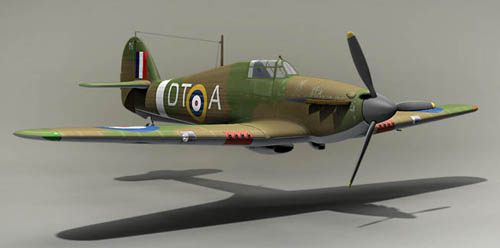| |
Aircraft reference and
information.


Hurricane
Sir Sydney Camm CBE

Sydney Camm C.B.E., F.R.Ae.S. was the man responsible for the design of
the Hawker Hurricane fighter and also the Hart, the Fury, the Typhoon,
Tempest, Sea Fury, Sea Hawk, the Hunter and the Harrier. A True Genius he was
born on the 4th of August 1893 in Windsor. As a young man was an aircraft
modeller. During the first World War he was employed by Martinsyde. He joined the
H.G.Hawker Engineering Company in 1923 and was appointed as chief designer in
1925. He was Knighted in 1953 for his outstanding services to The British
Aircraft Industry. He passed away on the 12th of March 1966.

History:
In 1933,
Hawker's chief designer, Sydney Camm, decided to design an aircraft which would
fulfil a British Air Ministry specification calling for a new monoplane
fighter. His prototype, powered by a 990hp Rolls Royce Merlin 'C' engine, first
flew on 6 November 1935, and quickly surpassed expectations and performance
estimates. Official trials began three months later, and in June 1936, Hawker
received an initial order for 600 aircraft from the Royal Air Force. The first
aircraft had fabric wings. To power the new aircraft (now officially designated
the "Hurricane,") the RAF ordered the new 1,030hp Merlin II engine.
Hurricane prototype

The first production Hurricane flew on 12
October 1937, and was delivered to the 111 Squadron at RAF Northolt two months
later. A year later, around 200 had been delivered, and demand for the airplane
had increased enough that Hawker contracted with the Gloster Aircraft company to
build them also. During the production run, the fabric-covered wing was replaced
by an all-metal one, a bullet-proof windscreen was added, and the engine was
upgraded to the Merlin III. Before WWII, production locations expanded to
include Yugoslavia, Belgium and in 1940, Canada, where it was undertaken by the
Canadian Car and Foundry Company.
Hurricane prototype

August 1940 brought what has become the
Hurricane's shining moment in history: The Battle of Britain. RAF Hurricanes
accounted for more enemy aircraft kills than all other defences combined,
including all aircraft and ground defences. Later in the war, the Hurricane
served admirably in North Africa, Burma, Malta, and nearly every other theatre
in which the RAF participated.
Mk 1 Hurricane

The Hurricane underwent many modifications
during its life, resulting in many major variants, including the
Mk IIA, with a Merlin XX engine; the Mk IIB,
with interchangeable wings housing twelve 7.7mm (0.303in) guns and carrying two
500lb bombs; the Mk IID, a tank buster with two
40mm anti-tank guns plus two 7.7mm guns; the Mk IV,
with a universal, multi-purpose wing, and powered by a 1,620hp Merlin 24/27
engine; and the Canadian-built Mk XII, with a
1,300hp Packard Merlin 29 engine. During the war, Hurricanes were sold to Egypt,
Finland, India, the Irish Air Corps, Persia, Turkey, and the USSR.

The Hurricane was undoubtedly one of the
greatest and most versatile fighter aircraft of WWII, and it remained in service
with the RAF until January 1947.

Hurricane Cockpit

Nicknames: Hurry;
Hurribomber (Malta-based Hurricanes)
Specifications (Mk IIB):
Engine: 1,280hp Rolls-Royce Merlin XX 12-cylinder V piston engine
Weight: Empty 5,500 lbs., Max Takeoff 7,300 lbs.
Wing Span: 40ft. 0in.
Length: 32ft. 2.5in.
Height: 13ft. 1in.
Performance:
Maximum Speed at 22,000 ft: 342 mph
Cruising Speed at 20,000 ft: 296 mph
Ceiling: 36,500 ft
Range: 480 miles
Armament:
Twelve 7.7mm (0.303in.) wing-mounted machine guns
Two 250 or 500-lb bombs
Number Built: 14,231
Number Still Airworthy: 6


|
|